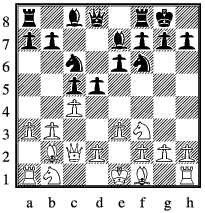
January 2014
Division 1
| ||||||||||||||||||||||||||||||||||||||||||||||||
Division 3
| ||||||||||||||||||||||||||||||||||||||||||||||||
Division 5
|
Division 2
| ||||||||||||||||||||||||||||||||||||||||||||||||||||||
Division 4
|
In division one Cheddleton A moved into contention with their win against Holmes Chapel, but as this was the only match played in December this competition continues to progress in slow motion.
All the second division teams played at least once. Knights were the big movers, two wins taking them into second place. This however did not stop Macclesfield extending their lead to four points. Most teams play three matches in January. If they don't make a dent in Macclesfield's lead in that time our Northern outpost will be well on the way to claiming the title.
At the other end of the table Alsager A are suffering considerably from player availability problems and have no points to prove it.
The third division table looks remarkably neat, with all teams having played six games. Perhaps it is something to do with the third being the only division suffering no postponements. A case of third best perhaps. Stafford B have finally lifted themselves off the bottom, but there will be no title challenge from them this year. Indeed one of the other teams will have to show remarkable form if the fight for top spot is not to be a straight Cheddleton E v Kidsgrove contest.
Into the fourth where all teams were active in December, yet the only positional change was for Newcastle D to leapfrog Alsager C in the more anonymous part of the table. At the top someone will need to put a dent into Fenton B's 100% record if they are to be stopped from running away with the title.
All teams also saw action in division five, with Fenton D jumping off the bottom to become the Meir teams closest challengers. But I still want to see more action before making any predictions about the final outcome here.
Elsewhere Kidsgrove removed Stafford from the Intermediate Cup, and Dave Buxto shared the honours with Alex Richardson in the second GP in this year's series.
Weather permitting there will be a bumber crop of results in examine in my next report. Hopefully this will mean all players have at least one game which represents a happy new year for them.
comment on this article

|
| RR v Phil Birks after 7 ... d5 |
8 d3 b6, 9 Nbd2 Bb7, 10 cxd5 exd5, 11 d4 Rc8
12 dxc5 bxc5 This seems an eminently sensible recapture to me, though Mr Stockfish seems to think keeping the c-file open is better, based on the idea of then immediately shoving his d-pawn against my uncastled king. Back to level.
13 Bd3 g6, 14 0-0 Na5, 15 Be5 I'm sure there is a good reason for wanting to put my bishop on the h2b8 diagonal, its just that said reason now escapes me.
15 ... Nd7, 16 Bf4 Bf6, 17 Rab1 Found it hard to decide which file I wanted the rook on. Perhaps I should simply have gone for doubling major pieces and dumped it on c1.
17 ... Re8
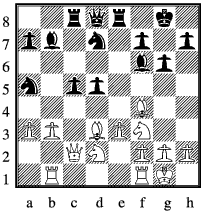
|
| RR v Phil Birks after 17 ... Re8 |
18 g4 Opening the h1a8 diagonal hardly counts as the cleverest option available to white.
18 ... c4, 19 bxc4 dxc4, 20 Be4 Showing RR's plan to justify g4. However Phil simply sidesteps the exchange of bishops, switching his attention to supporting his c-pawn which is now well on its way to escaping to victory. My silicon advisor tells me that in a couple of ill-judged move (g4 and Be4) I've built up a deficit equivalent roughly to a piece. Isn't losing easy?
20 ... Ba6, 21 Rfd1 Qe7 A momentary respite. c3 would have threatened several combinations leading to the unpleasantness of c2 and/or the loss of a minor piece.
22 Bd5 Nc5, 23 Nf1 getting out of the way of the c-pawn, but surely continuing my 'attack' with g5 would at least be consistent with earlier play. Truth is I'm refusing to acknowledge that my position is less than good, and therefore playing as if I have all the time I need to make kingside progress.
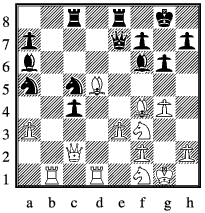
|
| RR v Phil Birks after 23 Nf1 |
24 g5 Bg7, 25 Bg3 which solves neither the problem of my hanging a-pawn, nor of the soon to be advancing black c-pawn. 25 ... Qc5, 26 e4 A move that I've been wanting to play for a while so that my f1 knight can go e3 and g4 and threaten the holes around his king. at the very least I would then be able to take his dark squared bishop out of the game, so giving a bit more breathing space around his c-pawn. But it's all so slow.
26 ... Bb5 Phil's turn to come up with a non-move. Creating no threat on the move, he also ties his queen down to the bishop's defence, thereby effectively protecting my a-pawn. I'm glad I'm not he only one who can come up with such efforts. Now I've a bit of time for furthering my own prospects.
27 Ne3 Nb3 An RR style panic move. Admitting that the last move was wrong and returning the bishop to a6 is considerably better.
28 Rxd3 Happy to give up the rook for both knights
28 ... Qxa3 Phil goes from bad to worse.

|
| RR v Phil Birks after 28 ... Qxa3 |
29 Rdxb3 cxb3 30 Qxb3 Qxb3, 31 Rxb3 Bc6, 32 Ra3 Re7
33 Bd6 Rb7, 34 Bxc6 Rxc6, 35 e5 f6, 36 Ng4 and Phil's flag falls before I have the chance to give the game back again. You'll gather therefore that Phil's poor moves were at least partly caused by time pressure. Wish the same could be said for mine.
comment on this article
Nic has kindly volunteered to taxi me to Telford for the Shropshire Congress, so here I am on Saturday ready for round one, with Steve Jukes opposite.
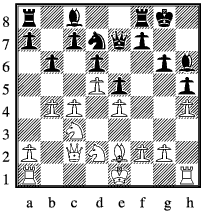
|
| RR v Steve Jukes after 13 N(f3)d2 |
13 ... a5, 14 b5 That's the queenside pawns sorted, though there is tons of space behind for pieces.
14 ... Nf6, 15 0-0-0 a4, 16 a3 That's a couple more elements available for a future plan - swap most bits off and snaffle his a-pawn, and relocate my c3 knight to c6 or a6 via a2 and b4.
16 ... Nd7 heading my way, 17 Kb2 taking the a-pawn this early is not part of my plans, though possibly I should not be concerned about his loading the a-file with major pieces as a reply.
17 ... Nc5 (I shall need to keep an eye on this knight)
18 Rdg1 Bg4, 19 Bxg4 hxg4 Disrupting the pawns seems a better idea than kicking the white-squared bishop with f3 as the latter would allow his other bishop to e3 and d4 making my king uncomfortable.
20 Nf1 Kg7, 21 h5 Bg5, 22 Qe2 Rh8, 23 hxg6 fxg6, 24 Qxg4 clang!
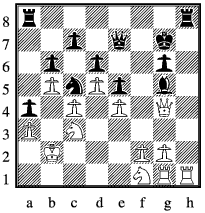
|
| RR v Steve Jukes after 24 Qxg4?? |
24 ... Nd3+ Bet you saw that coming. Said I'd have to keep an eye on that knight. Maybe if I play Kc2 he'll grab the f-pawn immediately and I can get two rooks for queen.
25 Kc2 Rxh1, 26 Rxh1 Nxf2 Regular readers will know that RR is not good at resigning, though playing on a rook down is definitely pushing it. Somehow I've got to start reducing the pawn count, which means getting a knight into his pawns.
27 Qe6 Nxh1, 28 Nh2 Qxe6, 29 dxe6 Re8, 30 Nd5 Rxe6, 31 Nxc7 Rf6 Offers the exchange as further simplification, but instead I elect to bring the other knight into the game, covering f2.
32 Ng4 Rf4 Now I have no choice. But at least it gives the additional chance that if I can liquidate all the pawns, even if I have to sac my last knight to do so, he may not know the bishop and knight mate.
33 Ne6+ Kg8, 34 Nxf4 Bxf4, 35 Nf6+ Kf7, 36 Nd5 Nf2
37 Nxb6 Nxe4, 38 Nxa4 Nc5, 39 Nxc5 dxc5, 40 Kd3 Ke7
41 a4 Kd6, 42 a5 Kc7, 43 Ke4 Bd2, 44 Kxe5 Bxa5
45 Kf6 Kd6, 46 g4 Bd8+, 47 Kxg6 Ke5, 48 Kf7 Kd4
49 Ke8 Kxc4 ½ - ½
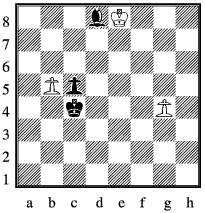
|
| RR v Steve Jukes, Final position |
Yes there were plenty of options for black to hold his advantage, but from RR's side the important thing was to give black chances to go wrong rather than simply sitting hoping he would. When losing, never forget how difficult winning won games can be.
comment on this article
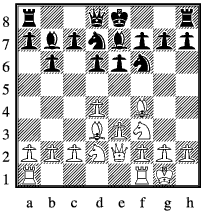
|
| Stefan Tennant v RR after 8 0-0 |
8 ... Nh5, 9 Bg3 0-0 No hurry to lop the bishop off.
10 h4 Nxg3 Now that the h-pawn has moved the exchange on g3 weakens his kingside defences. However he is playing like a man with designs on my king, so maybe he doesn't mind.
11 fxg3 c5, 12 c3 h6 hardly necessary, but does no harm either.
13 Ne4 Aggressively posted, but going where?
13 ... Rc8, 14 Nh2 c4 Not wanting any nonsense with Ba6 from white.
15 Bc2 Qc7, 16 Qh5 He's playing a different game to me. Time to grab some pawns.
16 ... Bxe4, 17 Bxe4 d4, 18 Bc2 Qxg3 (one), 19 Rf3 Qxh4 (two)
And that's basically it folks. Stefan played on into a bishop against knight ending, but resigned on move 45 with my knight about to make the deficit four pawns. For once a game that was relatively painless from RR's side.
comment on this article
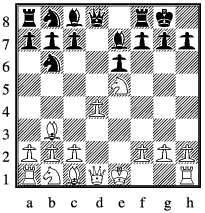
|
| Chris Lewis v RR after 7 ... 0-0 |
8 f4 Pushing pawns is fun, but can he really neglect king safety?
8 ... c4, 9 c3 cxd4, 10 cxd4 Nc6 Give me a target and I'm happy to hit it. Not worried about creating an isolated pawn of my own. Reckon in this position open lines and diagonals are more important.
11 Nxc6 bxc6, 12 0-0 Bf6, 13 Be3 Ba6, 14 Rf3 bent on kingside aggression
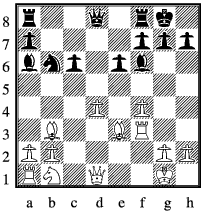
|
| Chris Lewis v RR after 14 Rf3 |
14 ... Bc4, 15 Nd2 Bxb3, 16 Nxb3 Nd5, 17 g4 Every time white makes an aggressive move Stockfish says 'I want to be black'. And then I let white off the hook.
17 ... Qd6, 18 Bc1 Bd8, 19 a4 a5, 20 Nc5 Bc6
21 Ne4 Qd7, 22 Rg3 Ne7, 23 Be3 Rfd8, 24 Ra3 Bxd4 the d-pawn finally falls, and there is no way back for white.
25 Rd3 Bxe3+, 26 Rgxe3 Nd5, 27 Qf3 Qa7, 28 g5 hoping for a snap mate on g7, but its too slow
28 ... Nxe3, 29 Rxe3 Rd3 0-1
A game of pins, first of the d4 pawn and then of the occupant of e3. Not the most efficient dispatch perhaps, but a wins a win.
comment on this article
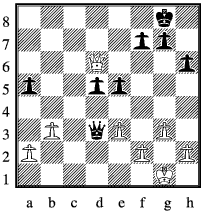
|
| RR v Athar Mehmood after 31 Qx(B)d6 |
38 Qxa5 Qb1+, 39 Kg2 d3 Now it starts getting hairy. Do not even think of Qd2 to blockade the pawn, or rying to get the king across. that way lies disaster.
40 Qd5 Qc2, 41 Qe4+ g6, 42 g4 to inhibit f5. However this is unnecessary as f5 could be met with Qxe5 and threats of perpetual. Hence I could have started an advance of a queenside pawn.
42 ... Qe2, 43 Qc4 Kg7, 44 h3 e4, 45 Qd4+ Kg8
46 Qd6+ Kg7, 47 Qd4+ Kh7, 48 Qf6 ½ - ½
Slightly nervewracking, but a save draw.
comment on this article
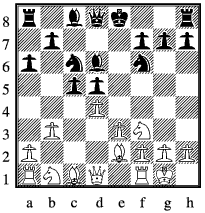
|
| RR v Ray Hyde after 8 ... Bd6 |
9 dxc5 Bxc5, 10 Bb2 Be6, 11 a3 0-0, 12 Qc2 Bd6
13 Nbd2 Rc8, 14 Rac1 Nd4, 15 Qd1 (Qd3 better, as it leaves rooks connected)
15 ... Rxc1, 16 Bxc1 Nxe2+, 17 Qxe2 Qe7, 18 b4 Rc8
19 Nd4 Ng4, 20 N2f3 Ne5, 21 Nxe5 Bxe5, 22 Bb2 Bd6
23 f4 f5, 24 Qd3 Qf7
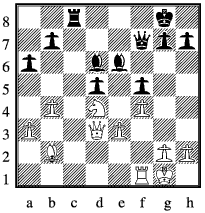
|
| RR v Ray Hyde after 24 ... Qf7 |
25 Rf3 g6 Ray sees the same shadows as RR, but this nudge merely helps the white attack.
26 Nxe6 Qxe6, 27 Qd4 Rc7, 28 Qh8+ Kf7, 29 Qxh7+ Ke8
30 Qh8+ Kd7, 31 Rh3 Bxf4 The e-pawn is pinned against mate, so cannot recapture. It looks like black has found a counter-attack, but white's attack is faster. However had he found Rc2 black would still be in the game.
32 Rh7+ Kd6, 33 Qf8+ 1-0 33 ... Kc6 is mate in one, blocking the check results in mass exchanges from which RR emerges a bishop up in an otherwise pawn ending.
So RR's change of tack did not cost, but in retrospect I think I'd prefer to have continued with plan A which represented a surer way to success.
comment on this article
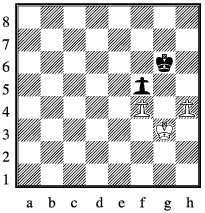
|

|
Try again.
1 Kf2 Kh4, 2 Ke2 Kxh3, 3 Kd3 Kg2
Just a small change. White has to defend his pawn. Ke4 quickly leads to the position right except that it is white to play and hence white who has to abandon his pawn and the game. Ke2 fares no better for after Kg3 by black white cannot maintain protection of his pawn.
Indeed white is lost as soon as he plays 2 Ke2, unless black goes wrong. White was indeed correct to take the draw.
Now another small change. Move the whole position one rank further up the board.

|
Now if black is careless and plays Kg4, white sets up a win with Ke5. If black doesn't go wrong
3 ... Kg3, 4 Ke3 Kg4, 5 Ke2 Kxf4, 6 Kf2 and the opposition holds the draw. (Note the importance of 5 Ke2 to set up the opposition. If black is allowed the opposition he wins.) Thus one rank further up the board and white has a free go at giving black the chance to wrong.
The opposition trick doesn't work in the original set-up as king on the sixth in front of his pawn always wins, as all players should know. If you don't, set it up and play it out to convince yourself of the truth of the statement.
comment on this article
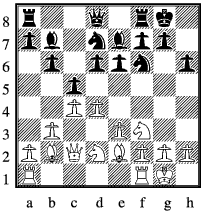
|
| RR v Stephane Pedder after 10 ... h6 |
11 e4 cxd4, 12 Nxd4 Rc8, 13 Rac1 Nh7 After the game Stephane berated himself for this move, but whilst that might be better moves available, this is hardly a game changer as far as the rsult is concerned, though it does set the pattern for the game by encouraging me to commit to an attack. Can't resist the temptation to keep the knight out of g5, so
14 f4 For once my silicon advisor does not snigger at this advance
14 ... d5
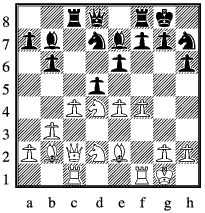
|
| RR v Stephane Pedder after 14 ... d5 |
15 exd5 exd5, 16 Bf3 Wanted to play Nf5, but having opened the position didn't feel that allowing the exchange of dark squared bishops was best. What do I know? So went for this pin instead.
16 ... Nhf6, 17 Nf5 Bc5+, 18 Kh1 Nb8 Stephane didn't mention this knight retreat, but Stocky hates it, suggesting black should be playing on the e-file with Re8.
19 Qd3 (Qb1 more sensible) Na6, 20 cxd5 Nb4
21 Qb1 Bxd5, 22 a3 Bxf3, 23 Rxf3 Nbd5
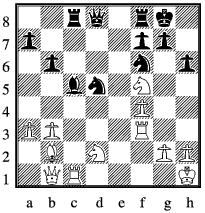
|
| RR v Stephane Pedder after 23 Nbd5 |
24 Nc4 b5, 25 Ne5 Ne7
Time for fun
26 Nxh6+ gxh6, 27 Rg3+ Kh8, 28 Nd7 Neg8, 29 Rxg8+ Rxg8
Kxg8 draws Nxf6+
30 Bxf6+ Qxf6, 31 Nxf6 Rg6, 32 Qb2 Rd8
I might fall for the back row mate or allow Bd4. But I don't.
33 Nd7+ 1-0 Revenge.
comment on this article
We join the game for move 12. Black has designs on the e-pawn, but can he safely take it if white castles?
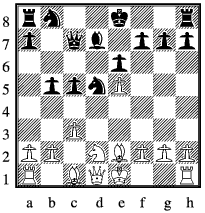
|
| Doug Barnett v RR after 11 ... Qc7 |
16 ... Ke7 Pardon? Worried about
16 ... Bxb5, 17 Nd6+ winning the bishop? Sorry not legal. The knight would be pinned against the white king. A case of the pin is mightier than the fork. Or perhaps he's played the follow up move to the capture first, having spent time deciding whether or not to castle in due course. Even RR is not sure what goes on in his mind, so you dear reader have no chance. Anyway, he has just turned a good position into a lost one.
17 Be3 Surely a4 comes first? Doug throws the advantage back to a position of near equality. Now RR can take that c pawn.
17 ... Rc8 RR's turn to say "No, no. I insist you win".
18 a4 "Ok, if you insist".
18 ... Be8 RR starts trying to unscramble his pieces. Diagram right.
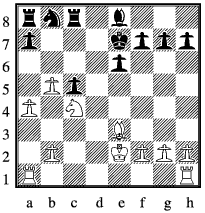
|
| Doug Barnett v RR after 18 ... Be8 |
19 ... Nd7, 20 Rac1 Rc7 RR deepens his trench. having vaccilated between playing Nb6 and f6, he comes up with a move that positively encourages Doug to rearrange his minor pieces in a useful manner.
21 Bf4 Rcc8, 22 Nd6 Rcb8, 23 Nc4 Rc8 Perhaps I can escape with a draw by repetition.
24 Bd6+ No chance. Doug introduces plan B.
24 ... Kf6, 25 a5 Nb8, 26 b6 Bc6, 27 Ne5 (Be5+ vacating d6 for the knight is surely better)
27 ... Bb5+, 28 Ke1 moves the king away from rather than towards the action.
28 ... axb6, 29 axb6 Ra2 Gets one rook out of the line of fire.
30 b7 Rd8 vague thoughts of Rxd6 and then picking up the knight.
31 Rxc5 The pawn goes at last, hitting my bishop and protecting his knight against my vague hopes. Diagram left
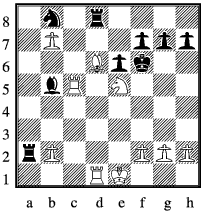
|
| Doug Barnett v RR after 31 Rxc5 |
31 ... Bxb2
Now he can play
32 Bxb8 Rxb8, 33 Rxb5 Rxb5, 34 Nd7+ to emerge a piece for a pawn to the good
whereas grabbing the bishop first allows
32 Rxb5 Rxb5, 33 Bxb8 Rxd1+, 34 Kxd1 Rxb7 covering d7. Black emerges with rook and pawn for knight and bishop and so lives to fight on.
What will he choose?
32 Bxb8 Oops. Sorry Doug. There is another line.
32 ... Re2+ 0-1
33 Kf1 (forced) Rxd1# would follow.
Doug was winning more convincingly and for longer, but looking in the paper in the morning shows RR won. Such is the game we have chosen to play.
comment on this article
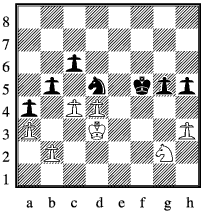
|
| John Yee v RR after 46 c4 |
46 ... Nf4+, 47 Nxf4 bxc4+, 48 Kxc4 Kxf4, 49 Kc5 g4
50 hxg4 hxg4, 51 Kxc6 g3, 52 d5 g2, 53 d6 g1Q, 54 d7
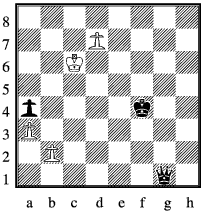
|
| John Yee v RR after 46 c4 |
All this should be easily calculable from the diagrammed position. From which you'll gather RR didn't. With over ten minutes still available RR convinced himself there might be a repetition in there and looked for other options. How about grabbing the b-pawn, exchanging the queen that white would create, and winning the game with the a-pawn. Certainly RR's king would get there before whites. Only danger is that of confinement. However you won't be surprised that if RR couldn't see through to the mate above clearly, then his checking for confinement was also incomplete. However he took it on trust (fool) and the game continued:
54 ... Qc1+, 55 Kd6 Qxb2(w), 56 d8Q Qd4+, 57 Ke7 Qxd8+
58 Kxd8 Ke4, 59 Kc7(x) Kd4(y), 60 Kc6(z) Kc4, 61 Kb6 Kb3 0-1
In fact the moves marked w, x, y and z are all blunders which should alter the result of the game: w turns a win for RR into a draw, x makes it a win again, y turns it back into a draw, and z gives the final decisive twist back to a win. It is all to do with confinement, which to his shame RR knows about, was aware might arise, yet still walked into.
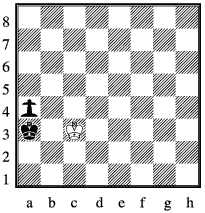
|
| Confinement |
So what went wrong in the game? White should plan to sweep round to the kingside of the black king which approaches the a3 pawn by a series of horizontal moves (ie along a rank) and diagonal ones. If white can arrange for there to be just two ranks between the kings when black still has at least two horizontal moves to make and white able to move kingside of black, then on each of those horizontal moves white can gain a rank to end level with the black king. so back to move 59 and try
59 Ke7 Ke5 (taking opposition is normally best)
60 Kf7 Kd4, 61 Ke6 Kc4, 62 Ke5 gains a rank
62 ... Kb3, 63 Kd4 Kxa3, 64 Kc3 confinement ½-½
Having seen the principle, you should also be able to check that other lines of approach to the a-pawn for black are no better.
So that is what is wrong with move (x), and so by implication we see that (w) was wrong. How about (y), the Kd4 move? The correct move here was Kd5, placing he black king on the diagonal to b3. There, with only horizontal move to make white needs to be kingside of black and just one rank behind, which he cannot achieve from c7, thereby guaranteeing the win for black. Kd4 however allowed white to play Kd6, a successful taking the opposition move as white is ready to move kingside of black and is only two ranks behind him with black still to make two horizontal moves. Confinement and a draw beckons.
comment on this article